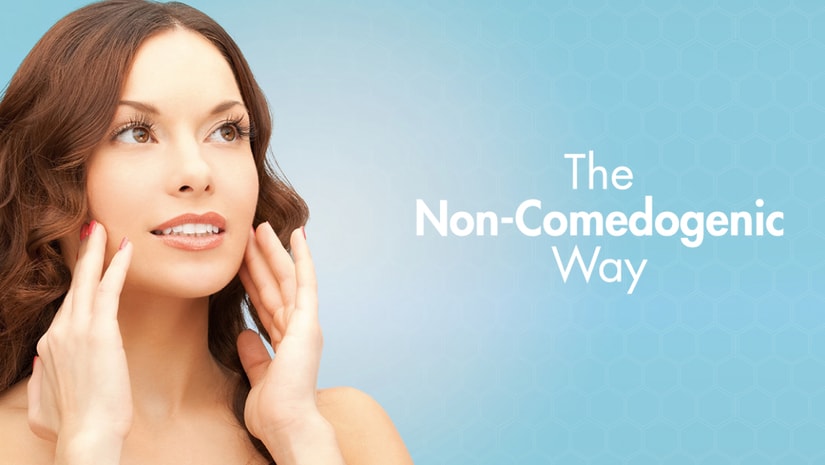For those of you that don’t know, Non Comedogenic Makeup (NCM) is makeup that contains specific ingredients that are proven not to clog or block pores. The term comedogenic derives from the word ‘comedo’ which is a type of acne skin lesion that occurs when oil and dead skin becomes trapped within hair follicles (colloquially referred to as blackheads, among other things). A number of ingredients have been proven not to lead to blocked pores, some of which are outlined below and it is these that should be listed in any NCM you buy.
Why you should use Non Comedogenic Makeup
Blackheads, acne and other skin lesions can develop due to a number of factors, including overactive glands, abnormal shedding of skin cells and an excess of dead skin and oil that builds up in pores. This can all happen naturally and irrespective of your skin care regime. However, the use of certain types of cosmetics can dramatically escalate the problem. In particular the use of chemically laden makeup, foundation and other creams and lotions can lead to the blocking of pores, and subsequently the development of spots and blackheads. Using NCM helps to alleviate and prevent skin problems such as these.
The problem of product claims
The problem with buying and using makeup labelled as NCM is that no approved regulatory standards exist regarding the labeling or the type of ingredients used in cosmetics that make the claim to be NCM. Essentially, any company can label their product as NCM, regardless of what it contains! They could even do this if it contained ingredients that are well known to cause break-outs!
As a consumer you obviously want to ensure that you are getting what you pay for, particularly as NCM labelled cosmetic products can be more expensive that regular makeup. One way to do this is to look in detail at the ingredient lists on the back of the product (not just the active ingredients mentioned on the front label) and avoid purchasing the product if the chemicals and oils that are known to cause breakouts are present. To help you do this the lists below outline the most common ingredients that you want to avoid, and those that you should look out for as they have non comedogenic properties.
The solution
Looking at the two ingredient lists at the bottom of this page and examining cosmetic labels for these ingredients before you purchase is a perfectly acceptable method for checking that you get what you want – a makeup that doesn’t clog pores. It is however time consuming and can be confusing when the number of ingredients involved are so high. A much simpler method is to look at the unique comparison chart above, where the hard work has been done for you.
Comedogenic Ingredients to avoid:
- Parabens
- Silicone
- Bismuth oxychloride
- Sodium chloride
- Cetylated Lanolin
Also: Algae Extract, Butyl Sterate, Cocoa Butter, Coconut Butter, Coconut Oil, Colloidal Sulfur, Corn Oil, D & C Red #17,21,3, Glyceryl Stearate SE, Isocetyl Stearate, Isopropyl Isostearate, Isopropyl Myristate, Isopropyl Palmitate, Laureth 23, 4, Lauric Acid, Myristic Acid, Octyl Palmitate, Octyl Stearate, Oleth-3 PEG 75, Lanolin PEG 16, Lanolin PEG 8, Stearate, Propylene, Glycol Monostearate, Sodium Laureth Sulfate, Sodium Lauryl Sulfate, Soybean Oil, Wheat Germ Oil.
Non comedogenic makeup Ingredients to look out for:
Although no ingredients can officially be labelled as non comedogenic due to the lack of regulatory standards, there are a number of ingredients that you should look out for due to their NC properties:
- Aloe vera extract; well known to have soothing, moisturizing and anti-inflammatory properties.
- Chamomile flower extract; contains antioxidants and anti-inflammatories that help with smooth looking skin.
- Jojoba seed oil; a natural moisturizer that does not block pores.
- Calendula flower extract; anti-inflammatory that soothes irritated skin.
- Witch hazel extract; a natural astringent that keeps skin hydrated.
- St. John’s wort extract; antioxidant compound that reduces inflammation and dry skin.
- Tea tree extract; Natural antibacterial compound that maintains the skin’s pH balance.
- Willow bark extract; a natural alternative to salicylic acid which exfoliates and de-clogs the skin.
- Bentonite; a natural clay that gets rid of toxins in the skin.


